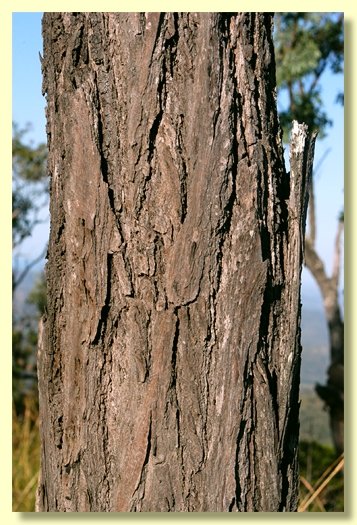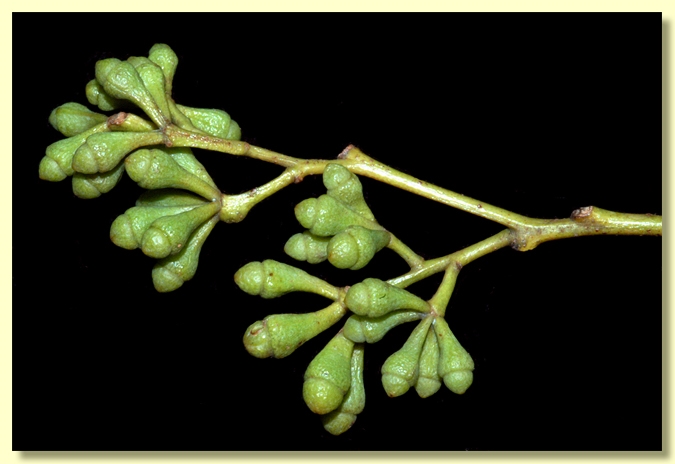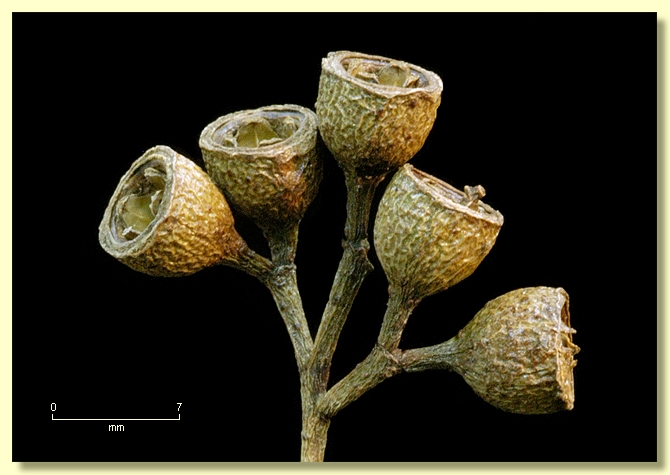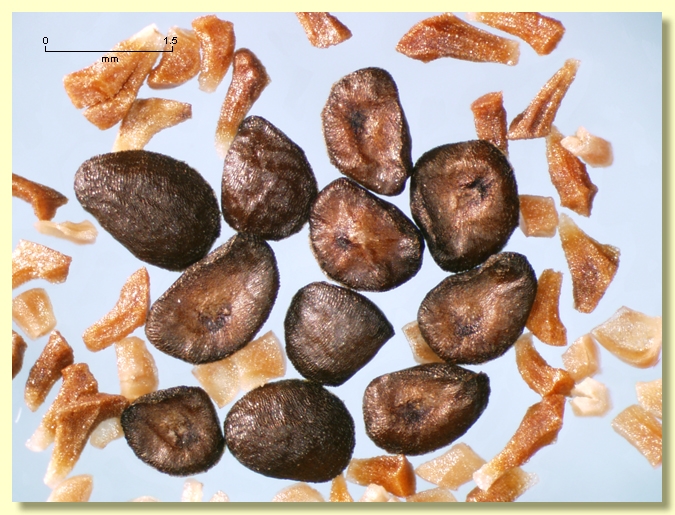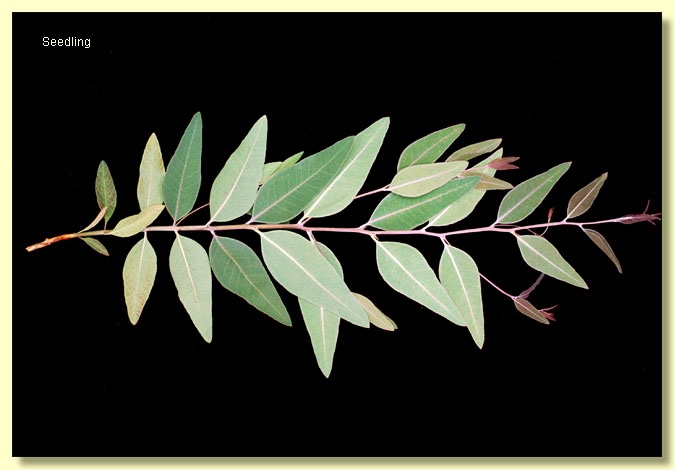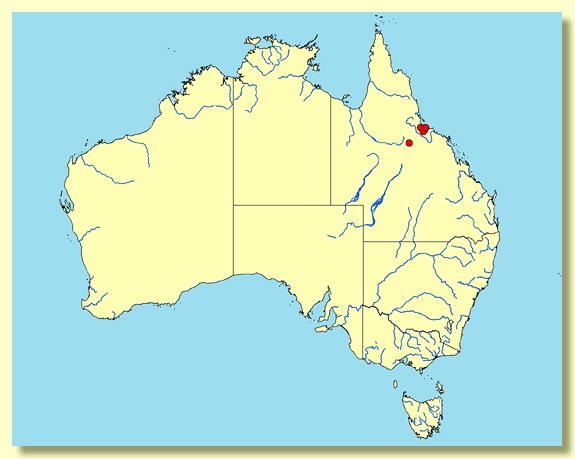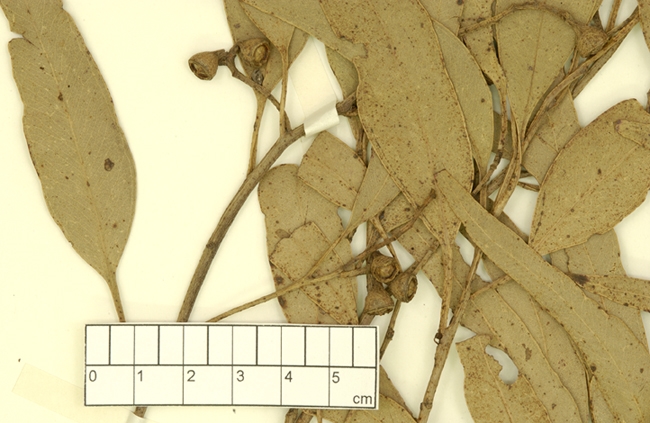Euclid - Online edition
Eucalyptus paedoglauca
Eucalyptus | Symphyomyrtus | Adnataria | Apicales | Siderophloiae | Subglaucae
Usually a small tree to 10 m tall, occasionally taller to 17 m. Forming a lignotuber.
Ironbark to the small branches, dark grey to black; branchlets usually glaucous but glaucescence fading with age.
Juvenile growth (coppice or field seedlings to 50 cm): stem square in cross-section, glaucous; juvenile leaves petiolate, alternate, ovate to broadly lanceolate, 8–15 cm long, 3.5–7 cm wide, base rounded or tapering to petiole, glaucous.
Adult leaves alternate, petiole 1–2 cm long; blade lanceolate, 8–14 cm long, 1.7–3.2 cm wide, base tapering to petiole, concolorous, dull to rarely slightly glossy, grey-green to green, side-veins normally at an angle greater than 45° to midrib, densely reticulate, intramarginal vein parallel to and just within margin, oil glands intersectional.
Inflorescence terminal compound, peduncles 0.4–0.9 cm long, buds usually 7 per umbel, rarely 3s, pedicels 0.2–0.5 cm long. Mature buds obovoid to ovoid, ca 0.7 cm long, ca 0.4 cm wide, scar usually present (first operculum sheds very early in bud development), operculum conical to rounded, stamens irregularly flexed, anthers cuboid, adnate, slits or pores separate, style long, stigma pin-head shaped, locules 4, the placentae each with 4 vertical ovule rows. Flowers white.
Fruit on pedicels 0.2–0.5 cm long, cup-shaped, 0.5–0.7 cm long, 0.5–0.7 cm wide, disc descending, valves 4, tips near the rim or enclosed or sometimes slightly exserted. (There may be a persistent staminophore which can be misinterpreted as a raised disc).
Seeds brown, 1.5–2 mm long, flattened-ovoid, dorsal surface shallowly reticulate, hilum ventral.
Cultivated seedlings (measured at ca node 10):cotyledons small, reniform; stems square in cross-section, glaucous; leaves always petiolate, opposite for 5–7 nodes then alternate, ovate-lanceolate, 7.5–9.7 cm long, 2–3.5 cm wide, base tapering, margin entire, apex pointed, discolorous, dull, slightly glaucous over green to grey-green.
Flowering time not known.
A small ironbark tree known only from Mt Stuart, in the western suburbs of Townsville, Pepper Pot Mountain and Mount Elliot just south of Townsville and from a mountaintop just north-east of Fanning River, south-west of Townsville. Characterised by its dull green to blue-grey to glaucous adult leaves and its broadly lanceolate to ovate glaucous juveniles.
Within its subgroup E. paedoglauca is very close to E. atrata and may be conspecific with it. Both species have dull blue-grey to glaucous adult leaves, broad glaucous juveniles and obovoid buds with a blunt rounded operculum, where the operculum is often narrower than the hypanthium before it is fully developed. E. paedoglauca tends to be slightly less glaucous than E. atrata with non-glaucous buds and sometimes dull green adult leaves. (E. atrata is always glaucous in the buds.)
Other members of the subgroup with relatively broad glaucous juvenile leaves that may be confused with E. paedoglauca are E. fibrosa subsp. nubila, E. farinosa, E. quadricostata, E. shirleyi, E. melanophloia, E. whitei and E. staigeriana. E. fibrosa subsp. nubila is distinguished by having buds with a long acute operculum (blunt to rounded in E. paedoglauca); E. farinosa has orbicular juvenile leaves (broadly lanceolate to ovate in E. paedoglauca); E. quadricostata has buds and fruit that are square in cross-section (round in E. paedoglauca); E. shirleyi and E. melanophloia have sessile, opposite juvenile leaves in the mature crown; E. whitei and E. staigeriana have slightly narrower juveniles and buds that frequently have an acute operculum (usually blunt and rounded in E. paedoglauca). All other members of this subgroup either have juveniles that are much narrower than E. paedoglauca or their juveniles are green and not glaucous. E. paedoglauca sometimes intergrades with E. crebra in areas where the two species grow together.
No other ironbark should be confused with E. paedoglauca.
Eucalyptus paedoglauca is listed as "Vulnerable" under the Australian Government Environment Protection and Biodiversity Conservation Act 1999 (EPBC Act). Further information may be found at this web address:
http://www.environment.gov.au/cgi-bin/sprat/public/sprat.pl
MORE ABOUT IRONBARKS
Eucalyptus paedoglauca: Greek pais, paidos, a child or youth and glaukos, pale blue or grey, referring to the glaucous juvenile leaves.


